For those who have been following us since our debuts, Acolad Community often sets up training sessions and webinars in collaboration with our teams of project managers and vendor managers. From new technologies to tips for making the most of CAT Tools, we aim to give the keys to learn essential skills and adapt to a changing industry. On November 19th, we organized a webinar on machine translation and post-edition, with senior translator Rhett Whitaker from Amplexor (an Acolad company). Here is the report of the session and the answers to questions that have been asked:
An interesting and excellent presentation for 60 Acoladers & Acoladees
This webinar about MTPE was hosted by senior translator Rhett Whitaker – with Anne Ronge, Resource Manager from Amplexor (an Acolad company), and Marion Ettviller, our Community Manager, as moderators. There were about 60 attendees, plus 185 translators who previously registered in order to be able to listen to the recording later. This session consisted in a 45-minutes presentation and a lively Q&A session at the end. The content of the webinar included what skills and mindset are necessary for MTPE projects, common errors in MT output and how to avoid them, and tips and tricks for ensuring quality with MT among other topics.



We are proud to see that very attendee enjoyed the webinar, as they said in their own words that the presentation was “very good”, “instructive” and “interesting”.

Questions from the webinar: what you need to know about MTPE projects
Some of you may want to know more about MT and how to carry on post-editing projects. If you do, take the time to read at the answers we gave during the Q&A session:
When post-editing, will I also see the original source text, or only the MT output?
In most cases, you will see the original source text next to the MT output. MTPE is usually carried out in a CAT tool, so the layout is indistinguishable from that of standard translation (source and target texts visible side-by-side). In certain exceptional cases, you may have to perform MTPE outside of the context of a CAT tool (e.g. directly in MS Word). In such instances, the source document should be made available to you with the other project resources.
What is “term blindness”?
This is a concept/term that I have come to use over the years (i.e. not a standard industry term) to talk about a phenomenon that often arises when post-editing. Namely, the tendency of post-editors to overlook the use and consistency of terminology in the document as a whole due to the intense focus on individual segments that is often needed while post-editing. Automated QA checks can help catch these omissions and inconsistencies prior to delivery, and a final read-through of the target text can aid in identifying terminology that has not been included in the termbase (but which should still be used consistently and accurately).
What should I do with raw MT output that I deem to be unusable? Can I simply discard it and translate from scratch?
Discarding unusable MT output for individual segments is allowed, but doing so makes subsequent MT engine retraining efforts less effective. If you deem that you would save significant time and effort by translating from scratch for a segment, then please do so – and make note of the deficient MT output so that you can report it to your project manager. If you have concerns about the MT output for a project in general, please notify your project manager (see additional info below).
Does Acolad have mechanisms in place to inform clients that post-edited content is not a cover-all replacement for human translation (i.e. more suitable for certain purposes than others)?
Yes – but our reporting is only as good as the feedback we get from our linguists. We do our best to paint an accurate picture for our clients in terms of where their expectations meet reality. When working on an MTPE project, please provide us with all the input you can with regard to error patterns in the text, unusable MT output (for which you have to translate from scratch), and any other examples you can give in terms of the overall suitability of MT for the text in question.
Does Acolad use MTPE as a matter of course, or is the default service still translation?
While translation still represents a significant portion of project volumes, demand for MTPE is high and continues to accelerate. The future makeup of the market is not clear in a highly detailed sense, but it is safe to say that MTPE is going to be a central part of the language services industry for years to come.
How do I know when to stop editing MT output? How close does it have to be to what I would translate from scratch?
Deciding whether to lean into the MT engine’s style or reshape the output to match your own style is one of the central challenges of MT post-editing, especially if you already have experience as a translator. A sense for what to do in this scenario usually comes with time and practice in post-editing. One trick to help this learning process along would be to try one style for 2-3 strings in the project you are working on, and then trying the other style for a further 2-3 strings. This can often give you a sense for which approach is easier for that given project, and you can proceed accordingly for the rest of the text.
If a client is dissatisfied with the final post-edited content they receive, to what extent is the post-editor held accountable?
If the document you deliver meets the project specifications, and you have been diligent in reporting any shortcomings you found in the MT output (error patterns, lack of suitability, etc.), there is usually a way forward when a client is dissatisfied with the outcome. We do our best to mediate client dissatisfaction in such a way that it resolves the issue and leaves our relationship with our linguist intact. It may be the case that we ask you to rework the text to better align with the client’s expectations.
If we receive a request for MT post-editing, is there room for us to say that we don’t think the text is suitable for processing in this way?
Yes, of course there is room for voicing concerns about overall suitability of a text for MTPE. In fact, the sooner you can report this kind of concern to us – and the more concrete examples you can provide from the project – the better. Please keep in mind that the way in which your input will be handled is likely to vary from project to project, as the specific circumstances of the project in question will dictate how best to proceed (client requirements, deadlines, and so on).
How long will it be before MT will be so good that no human interaction is needed? Will we have jobs in the future?
This level of MT sophistication does not seem to be coming anytime soon, at least in a comprehensive sense. MT has grown to be very competent at producing fairly straightforward, low-consequence texts – that is, texts which would result in few to no significant negative outcomes if errors did happen to appear. However, most of the projects you will be working on with us do not fall into this category: technical documentation, legal texts, and similar documents all have real-world consequences that require a human to be involved in the process in order to make sure that the intended meaning is conveyed accurately, consistently, and understandably in the target text. This human involvement also includes being able to understand and implement any additional instructions the client has provided. Even though MT engines increasingly understand how words in the target language are supposed to be arranged based on the source text, they do not understand the meaning of the output they generate. In the absence of true artificial intelligence, MT engines are and will continue to be incapable of providing this central component of the service we offer to our clients. For the foreseeable future, that responsibility will remain the domain of the human linguist.
NMT needs the human element to achieve quality. Some elements like cultural references, wordplay and humour, are everything a machine will never achieve to grasp. Only a human translator can do that. It’s all about building a relationship of trust with the translation engine.
